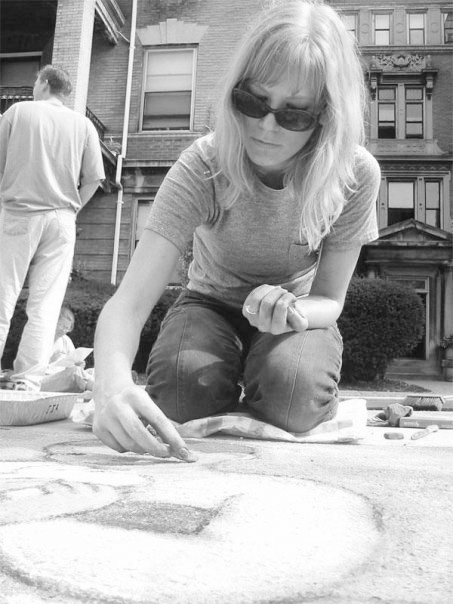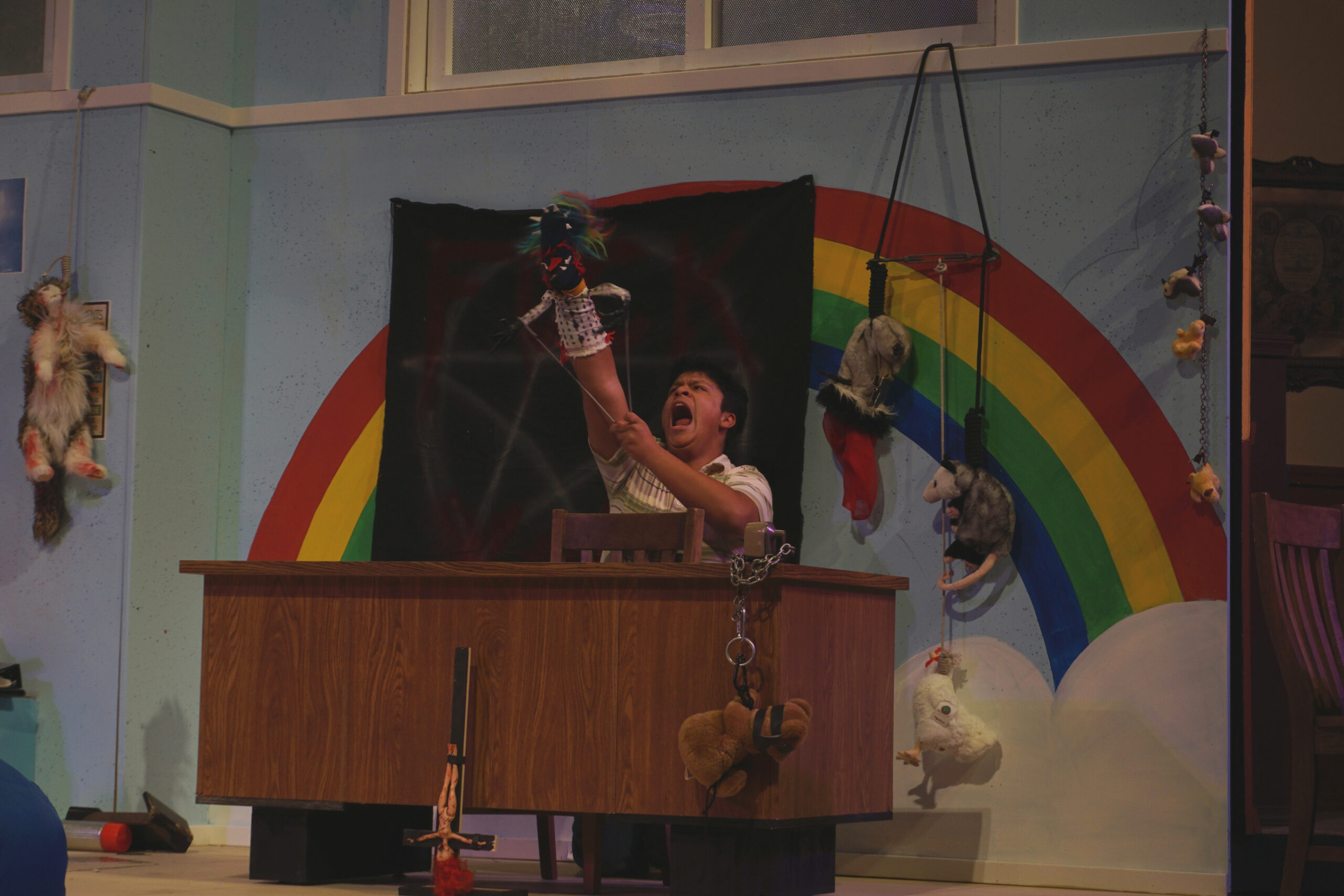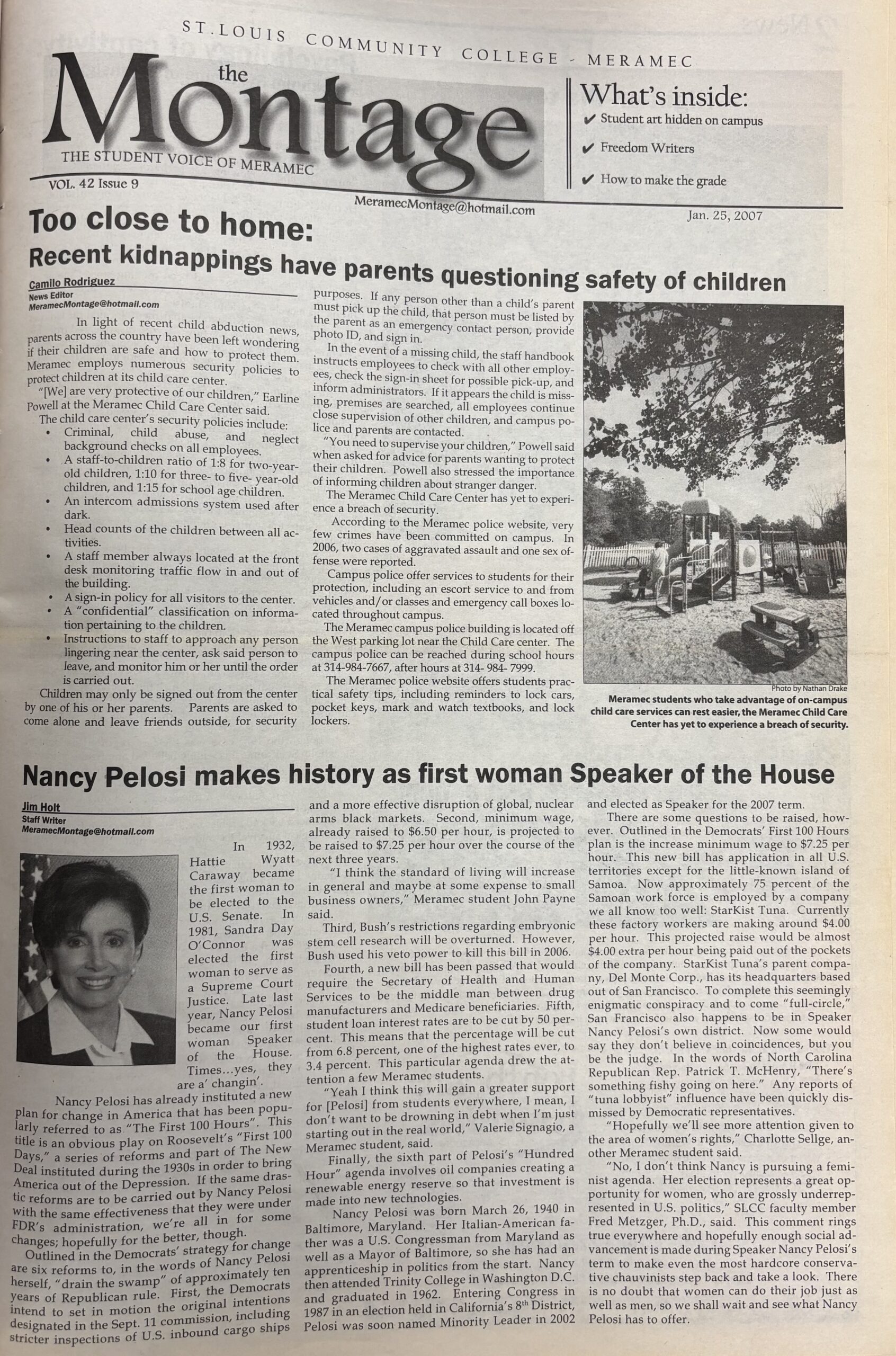Young Art Professionals Redefine Success for Future Generations
Staff Writer
The stereotype of the artist includes a furrowed brow, a pack of cigarettes and a head in the clouds. The culturally romanticized starving artist image may no longer be appropriate. So what does an art professional look like now?
In profiling several working artists in St. Louis, a different picture is painted. Serious work ethic, a sharp intellect and the ability to not only solve problems, but hurdle them, are the traits of contemporary art professionals.
The three artists profiled on this page have each graduated from a Masters of Fine Arts program in St. Louis within the last few years. They are teachers, technicians, business owners and community leaders. These profiles invite STLCC- Meramec art students just beginning their careers to learn from the mistakes and successes of their contemporaries.
Though their intentions may be to transfer to other institutions for their Bachelor of Fine Arts (BFA), Meramec art students may have a unique advantage on the cost of school and the quality of instruction.
“Students can really find themselves in this art department,” Dean of Humanities, Yvonne Johnson, said. “I came here from the University of Central Missouri where I was teacher for thirteen years and I think our art department here is every bit as good.”
“The instructors really try to allow students to grow in terms of their creativity while letting them know what opportunities there are for intellectual development,” Meramec photography professor, David Hanlon, said. “At the same time we give them some knowledge that they can continue studying with other professors and students who are exploring similar things at other schools. Locally, there are a number of schools I would refer students to”
STLCC has comprehensive articulation agreements with many local and regional schools. “Because our program is accredited by the National Association of Schools for Art and Design, there’s not a problem with transferring credits,” Hanlon said.
Metra Mitchell, Serhii Chrucky and Katie Millitzer have shared their unique stories with the hope that their advice reaches not only art students, but other young people with a variety of backgrounds, interests, and ambitions
Louis is a small town.”
——————–
METRA MITCHELL
Adjunct Professor of Art at Maryville, STLCC-FP, St. Charles Community College,
BFA from Western Kentucky University, 2006
MA and MFA from Fontbonne
University, 2010.
Know what you want to do with your art degree. “Some people say, ‘I want to make museum quality pieces,’ and it’s like ok, you can do that, but are you going to live off of that? Is this about developing your skills? Or is this about making money? Because you can get into any art school in the country if you’re willing to pay. If you’re somebody who’s getting your education because you want to make money off of this, and need to survive off this, then my advice would be to make as much art as you can art and learn how to show it.”
Make a lot of art and learn how to show it. “Don’t make art in the classroom and be afraid to put it in a hall display. I can’t tell you how many students take my classes – and I’ll make it a requirement to enter into the student show – and they’ll not show up the day they have to turn the stuff in for jurying. You’re taking art classes. And this is the student show. If you’re not going to do this, you’re not going to be applying to other venues. Show as much as you can.”
Teaching art is not easy. “If you’re looking at going the teaching route, try to teach whoever and wherever you can at whatever level, in order to learn how to do that. Most of my graduate school was spent making art in my studio and then being helping other people in the classroom. That was challenging. I had to learn how to juggle that. That was my real taste of what it’s like to not only have to deal with the struggles of your own creative process but have to deal with the things other people struggle with. And be able to handle 120 other people’s problems. I do think that not every great artist is cut out for being a great teacher, and I don’t think every teacher is a great artist.”
Have a plan but be willing to embrace everything. “Figure out exactly what you want to do with your degree now, while you’re working with it. Even if it’s a creative degree, you need to have a plan of attack. Yeah, there’s a lot of happenstance. You might get a show because you know somebody. At the end of the day, it is important to have the goals and the deadlines. That’s how the work gets made. My whole career has happened because I’ve never said no to anything. I’ve always said yes to everything. You just have to embrace everything. It’s strange, but it’s almost like an artist has to be an expert oneverything.”
———
KATIE MILLITZER
Owner of The Millitzer
Gallery and Studio
BFA 2002 from Webster University
MFA 2012 Washington University
Make smart financial decisions about your education. “If you have well-funded parents that saved money for your college – I don’t know what that’s like, but I hear that it happens – you take it however you wanna take it! But if you’re poor? Community college. Webster had scholarship transition out programs. If your family is broke, and you want to get into the arts, well, there’s no guarantee of a big salary. Depending on your circumstances, going to an art institute can be a very foolish move. Truth be told you should never take out more in student loans than you think you’re going to make in a year.”
Get to know yourself in undergrad. “[At Webster] they give you really loose assignments and they want you to forge your own path. I had friends that were like ‘I cannot handle this, they are not telling me what to do!’ I was kind of like, angry and tired from working so hard baking bagels all night long, and would try to take every assignment they gave me, turn it upside down and shove it back in their face in whatever way I could. And it always led to success for me, I always turned out a quality product. I thrived at a school like that. It was hard being poor in college, but it give me the ability to actually speak about my work and stand behind it in a more thoughtful way.”
St. Louis is a good place for artists and entrepreneurs. “The beautiful thing about this town is that the cost of living is so low. You could work somewhere part time, like a restaurant or bar, or whatever silly little thing is that you don’t mind doing and can squeeze a life out of that, and you cannot do that in larger art cities. There’s also the freedom of time when you have that. You can work less than twenty hours a week and live in a nice apartment with a room that you can paint in, or if you work a little bit harder you can even pay for an art studio.”
Create the environment that you see yourself working in. “Artists can build things with their hands. We’re almost better contractors than contractors. Use those skills to help create the venues that you see lacking. There are lots of secret art studios in this neighborhood, where groups of artists rent apartments. It’s not a big deal that they’re there, but they’re not allowed to put a sign out. I want my damn sign.”
Stay connected. “Make good friends and quality contacts. You never know who you may reconnect with in a decade, and St. Louis is a small town.”
———–
SERHII CHRUCKY
Adjunct Professor of
Photography at UMSL
BFA, University of ILL at Chicago, 2010
MFA, Washington University 2013
Do your prerequisites at community college. “Universities can be competitive on the front end, when all these high school students are applying. But they’ll have drop outs from that group, and they’ll need to fill seats. Transferring from a community college is actually a good way to get into a good school with less competition. I did it backwards, though. I went to Columbia College, which is a private art school, and then transferred to UIC. But when I got out of high school, I didn’t want to do anything else besides study photography.”
Get through the drudgery of prerequisites. “You need to take at least one class a semester that you truly enjoy.”
On ending up at Wash U. “The right thing to do is to find a school based not on geography, but based on the work of the other students and the professors there. I looked at portfolios for lots of schools, and tried to figure out where I’d fit in. That’s how I made my selection. Your own work will get you there, but no man is an island. You have to be careful where you pick, because you might get stuck there. I stayed here because of my friends from school. I decided to stay at least another year and ended up getting a teaching job which was through connections at Wash U.”
Work hard and be patient. “Concentrate on practicing and getting good at what you do. Because if you put your stuff out there too soon and it’s low quality, people will disregard you. You should [critique] in your classes, with your peers. School is an experimental lab for learning stuff that ends up translating to an external world, but not immediately. Patience is very important. You have to be focused and patient, and not flip flop.”
Learn how to talk about your work. “You have to be articulate, communicate well, and support your work in a number of ways. Graduate school is all about learning how to talk about your work, and other people’s work, and assimilate your ideas into a community of ideas. Writing is just another form of thinking. Practice writing as much as possible. Especially if you’re planning to go to graduate school. It’s something that gets lost in a highly visual culture.”
On the business of art and education. “Getting into shows seems to happen organically. I don’t like juried shows at all. I have a rule where I don’t pay any money to apply to something. Some would argue that that’s not a good thing, but it’s a principle of mine. It seems dirty, greasy, to try have to pay an application fee for a chance to show your work. But that’s business. [Application fees] are different, that’s a professional certificate. It’s all intertwined. There are no free schools in the United States, and that’s not my fault.”












